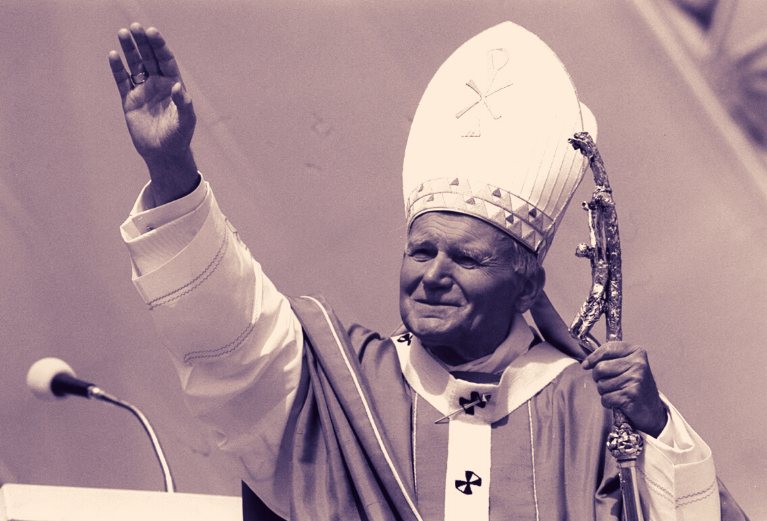Embodying and Revealing the Great Mystery: Day 18
Author: Andrew Comiskey
October 31, 2020
‘Although the spouses
should be “subject to one another in the fear of Christ” (this point is already
highlighted in the first verse of Ephesians 5:21-33), nevertheless in what
follows, the husband is above all the one who loves and the wife, by contrast, is
the one who is loved. One might even venture the idea that the wife’s
“submission” to the husband, understood in the context of the whole of
Ephesians 5:22-23, means above all “the experiencing of love.” This is all
the more so, because this “submission” refers to the image of the submission of
the Church to Christ, which certainly consists in experiencing His love.’ (TOB
92:6)

‘By the term “sign” we
mean here simply the “visibility of the Invisible.” The mystery hidden from
ages in God, that is, the Invisible, became visible first of all in the
historical event itself of Christ. The relationship of Christ with the
Church, which is defined in Ephesians as “mysterium magnum, the great
mystery,” constitutes the fulfillment and concretization of the visibility of
the same mystery. Moreover, the fact that the author of Ephesians compares the
indissoluble relationship of Christ and the Church with the relationship
between husband and wife, that is, with marriage--at the same time appealing to
the words of Genesis 2:24 that together with God’s creative act originally
instituted marriage--turns our reflection toward what we presented previously--in
the context of the very mystery of creation--as the “visibility of the
Invisible,” toward the very “origin” of man’s theological history.
One can say that the
visible sign of marriage “in the beginning,” in as much as it is linked to the
visible sign of Christ and the Church on the summit of God’s saving economy transposes the eternal plan of love into the “historical” dimension and makes it the
foundation of the whole sacramental order. It is a particular merit of the
author of Ephesians that he brought these two signs together, making of them
the single great sign, that is a great sacrament (“sacramentum magnum”).’
(TOB 95:7)
TOB crescendos with Eph.
5:21-33. Much can be said of St. Paul’s masterful convergence of Jesus’
consummation with His Church and marital sexuality. To compare the Master wooing
and preparing a people for Himself with our fine yet flawed efforts at making
marriage work seems a stretch. Yet is this not the ultimate shout-out to the
redemption of the body? Has not Jesus made man new, strong in dignity and
humility, capable of wooing woman and engendering a free response of her
feminine gift?
Here Jesus manifests that
He has done more than bring us back to the garden. He plays marital sexual love
forward as a sign of what is to come. Our weddings point to the ultimate one,
the Wedding Feast of the Lamb, toward which all creation groans and waits. That
means every sexual groan from the marriage bed echoes beyond itself to the cry
of every human heart. Ephesians 5 weds our bodily gift with what is most
ultimate and holy. Mysterious. Marvelous.
As a husband, I wrestle
with the incompleteness of my offering and too readily fall into ‘practicing
the presence’ of my limits. But Sts. Paul and John Paul II invite us into
something more. Every time I place Annette’s need over mine, each time I
lovingly caress her, every time we pray for and serve our kids, every
recollection with affection of her faithful ‘yes’ to God and me and a nearly
impossible vocation, the Spirit of Ephesians 5 amplifies our little marriage
into a larger icon of divine love.
My joy and goal are to
love Annette out of gratitude for how Jesus loves me. It’s not that
complicated. I trust Him to wash and empower me to be a better gift for her;
when secure in my love, her submission is easy. All people are inclined to submit
to good love, the husband first, then the wife.
We as marrieds become a
new sign--Eden washed, covered in the Blood, empowered by the Spirit--bearing
witness of the new Man Jesus who has a much bigger plan in mind than merely
joining two people together. He employs marriage as the witness to the most
important event in history--in truth, the culmination of history. Breathtaking.
That’s why St. John Paul II regards marriage as the foundation of all other seven
Catholic sacraments. I cannot grasp that. I guess if I could it would cease to be
a mystery. Perhaps all we can do is marvel.
‘Jesus, open the eyes of
our hearts to know a little more of this mystery. How can something so earthy
and even difficult be an icon of such glory? We see dimly but You see all and
we ask for wisdom and revelation to perceive things as You do. For marrieds, we
ask for grace to live this iconic reality with dignity. We ask that all singles
be strengthened and inspired by iconic marriages.’
'Jesus,
thank You for confirming Amy Coney Barrett to the US Supreme Court, Your
bright light in a dismal political season.'
BACK